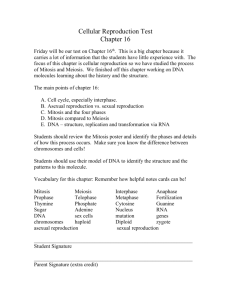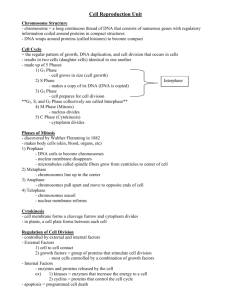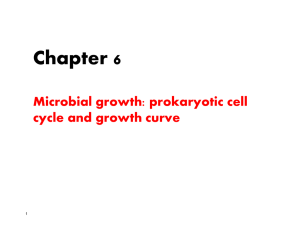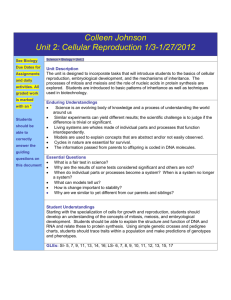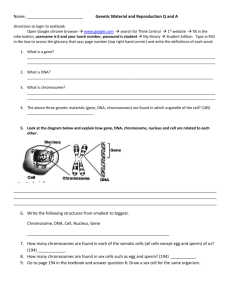Mitosis
advertisement
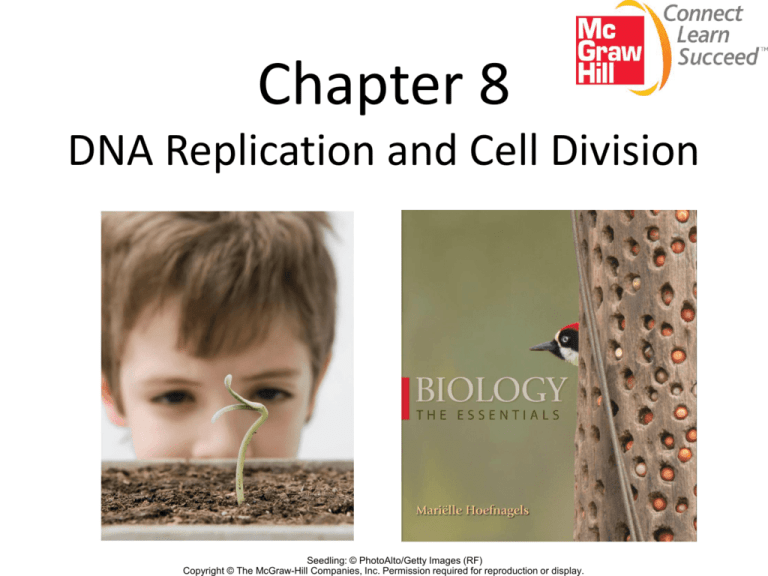
Chapter 8 DNA Replication and Cell Division Seedling: © PhotoAlto/Getty Images (RF) Copyright © The McGraw-Hill Companies, Inc. Permission required for reproduction or display. Cells Divide, and Cells Die Your cells are rapidly dying and being replaced. Section 8.1 Cells Divide, and Cells Die Cell division produces a continuous supply of replacement cells. Section 8.1 Cells Divide, and Cells Die Cell division also has a role in reproduction, growth, and development. Section 8.1 Two Types of Cell Division Interact in the Sexual Life Cycle A fertilized egg, or zygote, divides by mitosis. The fetus grows and develops into a mature adult consisting of countless cells with identical DNA. Section 8.1 Copyright © The McGraw-Hill Companies, Inc. Permission required for reproduction or display. Figure 8.1 Two Types of Cell Division Interact in the Sexual Life Cycle Each mature individual produces sex cells by another form of cell division called meiosis. Section 8.1 Copyright © The McGraw-Hill Companies, Inc. Permission required for reproduction or display. Figure 8.1 Two Types of Cell Division Interact in the Sexual Life Cycle Sex cells combine at fertilization. Section 8.1 Copyright © The McGraw-Hill Companies, Inc. Permission required for reproduction or display. Figure 8.1 Mitosis Has Many Roles Mitotic cell divisions allow an organism to grow and develop, repair tissues, and regenerate lost body parts. Some organisms reproduce asexually by mitosis. Section 8.1 Figure 8.2 Cell Death Is Part of Life Apoptosis, or cell death, carves out distinctive structures. Section 8.1 Copyright © The McGraw-Hill Companies, Inc. Permission required for reproduction or display. Figure 8.3 DNA Replication Precedes Cell Division For each of the daughter cells from this division to have identical DNA, the cell must first replicate its genome. Section 8.2 DNA Replication Precedes Cell Division DNA replication occurs in multiple steps. Section 8.2 Copyright © The McGraw-Hill Companies, Inc. Permission required for reproduction or display. Figure 8.4 DNA Replication Precedes Cell Division Enzymes, such as helicases, unwind and hold the DNA apart. Section 8.2 Copyright © The McGraw-Hill Companies, Inc. Permission required for reproduction or display. Figure 8.4 DNA Replication Precedes Cell Division Enzymes called DNA polymerases create strands that are complementary to the original strands. Section 8.2 Copyright © The McGraw-Hill Companies, Inc. Permission required for reproduction or display. Figure 8.4 DNA Replication Precedes Cell Division Ligases form covalent bonds between adjacent nucleotides. Section 8.2 Copyright © The McGraw-Hill Companies, Inc. Permission required for reproduction or display. Figure 8.4 DNA Replication Precedes Cell Division After replication, each DNA molecule has one parental strand and one daughter strand. Section 8.2 Copyright © The McGraw-Hill Companies, Inc. Permission required for reproduction or display. Figure 8.4 Clicker Question #2 The image at right shows a cell’s DNA before replication. Which of the following best represents the position of the newly created (red) DNA strands after replication is complete? A. B. © 1996 PhotoDisc, Inc./Getty Images/RF Copyright © The McGraw-Hill Companies, Inc. Permission required for reproduction or display. Clicker Question #2 The image at right shows a cell’s DNA before replication. Which of the following best represents the position of the newly created (red) DNA strands after replication is complete? A. B. © 1996 PhotoDisc, Inc./Getty Images/RF Copyright © The McGraw-Hill Companies, Inc. Permission required for reproduction or display. Prokaryotes Divide by Binary Fission In prokaryotes, reproduction occurs by binary fission, an asexual process that replicates DNA and distributes it to two daughter cells. Section 8.3 Copyright © The McGraw-Hill Companies, Inc. Permission required for reproduction or display. Figure 8.5 Prokaryotes Divide by Binary Fission Prokaryotes have one circular chromosome. Section 8.3 Copyright © The McGraw-Hill Companies, Inc. Permission required for reproduction or display. Figure 8.5 Prokaryotes Divide by Binary Fission As the cell prepares to divide, DNA replicates and attaches to the cell membrane. Section 8.3 Copyright © The McGraw-Hill Companies, Inc. Permission required for reproduction or display. Figure 8.5 Prokaryotes Divide by Binary Fission The cell membrane grows between the two DNA molecules. Section 8.3 Copyright © The McGraw-Hill Companies, Inc. Permission required for reproduction or display. Figure 8.5 Prokaryotes Divide by Binary Fission The cell divides in half, forming two daughter cells, each identical to the original. Section 8.3 Copyright © The McGraw-Hill Companies, Inc. Permission required for reproduction or display. Figure 8.5 Clicker Question #3 Why is binary fission an asexual process? A. It occurs only in prokaryotes. B. It does not require DNA replication. C. It produces two identical cells. D. The chromosome is circular. © 1996 PhotoDisc, Inc./Getty Images/RF Copyright © The McGraw-Hill Companies, Inc. Permission required for reproduction or display. Clicker Question #3 Why is binary fission an asexual process? A. It occurs only in prokaryotes. B. It does not require DNA replication. C. It produces two identical cells. D. The chromosome is circular. © 1996 PhotoDisc, Inc./Getty Images/RF Copyright © The McGraw-Hill Companies, Inc. Permission required for reproduction or display. Replicated Chromosomes Condense Before Cell Division Eukaryotic cells do not divide by binary fission. Instead, they divide by mitosis. Section 8.4 Figure 8.6 Replicated Chromosomes Condense Before Cell Division The DNA in the cell on the left is loose in the nucleus. The DNA in the cell on the right has condensed into visible chromosomes. Section 8.4 Figure 8.6 Replicated Chromosomes Condense Before Cell Division DNA replication and protein synthesis occur when DNA is loosely packed. Section 8.4 Figure 8.6 Replicated Chromosomes Condense Before Cell Division Cell division occurs when DNA has condensed into chromosomes. Section 8.4 Figure 8.6 Replicated Chromosomes Condense Before Cell Division Naked DNA wraps nucleosomes, groups of histone proteins. Section 8.4 Figure 8.7 Replicated Chromosomes Condense Before Cell Division Before cell division, nucleosomes cluster together into chromatin. Scaffold proteins within chromatin keep it tightly packed. Section 8.4 Copyright © The McGraw-Hill Companies, Inc. Permission required for reproduction or display. Figure 8.7 Replicated Chromosomes Condense Before Cell Division Eventually, discrete chromosomes form. The highly folded DNA takes up less space and is easier to move than unwound chromatin. Section 8.4 Copyright © The McGraw-Hill Companies, Inc. Permission required for reproduction or display. Figure 8.7 Mitotic Cell Division Generates Exact Copies The cell cycle describes the events that occur in one round of cell division. Section 8.5 Copyright © The McGraw-Hill Companies, Inc. Permission required for reproduction or display. Figure 8.8 Mitotic Cell Division Generates Exact Copies During interphase, the cell replicates its DNA and carries out many functions unrelated to cell division. Section 8.5 Copyright © The McGraw-Hill Companies, Inc. Permission required for reproduction or display. Figure 8.8 Mitotic Cell Division Generates Exact Copies During interphase, the cell replicates its DNA and carries out many functions unrelated to cell division. Section 8.5 Copyright © The McGraw-Hill Companies, Inc. Permission required for reproduction or display. Figure 8.8 Mitotic Cell Division Generates Exact Copies During interphase, the cell replicates its DNA and carries out many functions unrelated to cell division. Section 8.5 Copyright © The McGraw-Hill Companies, Inc. Permission required for reproduction or display. Figure 8.8 Mitotic Cell Division Generates Exact Copies During interphase, the cell replicates its DNA and carries out many functions unrelated to cell division. Section 8.5 Copyright © The McGraw-Hill Companies, Inc. Permission required for reproduction or display. Figure 8.8 Mitotic Cell Division Generates Exact Copies Mitosis is the division of the nucleus, and cytokinesis is the division of the cell itself. Section 8.5 Copyright © The McGraw-Hill Companies, Inc. Permission required for reproduction or display. Figure 8.8 Chromosomes Divide During Mitosis Section 8.5 Copyright © The McGraw-Hill Companies, Inc. Permission required for reproduction or display. Figure 8.9 Chromosomes Divide During Mitosis Section 8.5 Copyright © The McGraw-Hill Companies, Inc. Permission required for reproduction or display. Figure 8.9 Cytoplasm Splits in Cytokinesis In an animal cell, the first sign of cytokinesis is the cleavage furrow. Section 8.5 Figure 8.10 Cytoplasm Splits in Cytokinesis The cleavage furrow deepens as the ring of proteins beneath the cell membrane contracts. Section 8.5 Figure 8.10 Clicker Question #4 In some fungi and slime molds, mitosis may occur without cytokinesis. What would you expect to find in these species? A. Cells that don’t contain nuclei. B. Cells that contain multiple nuclei. C. DNA that never condenses into visible chromosomes. D. Nuclei that never enter interphase. © 1996 PhotoDisc, Inc./Getty Images/RF Copyright © The McGraw-Hill Companies, Inc. Permission required for reproduction or display. Clicker Question #4 In some fungi and slime molds, mitosis may occur without cytokinesis. What would you expect to find in these species? A. Cells that don’t contain nuclei. B. Cells that contain multiple nuclei. C. DNA that never condenses into visible chromosomes. D. Nuclei that never enter interphase. © 1996 PhotoDisc, Inc./Getty Images/RF Copyright © The McGraw-Hill Companies, Inc. Permission required for reproduction or display. Cancer Arises When Cells Divide Out of Control Chemical checkpoints regulate the cell cycle. But what if the body loses control of cell division? Section 8.6 Copyright © The McGraw-Hill Companies, Inc. Permission required for reproduction or display. Cancer Arises When Cells Divide Out of Control A tumor is an abnormal mass of tissue. The cells of a tumor divide out of control. Tumors are either benign or malignant. Section 8.6 Copyright © The McGraw-Hill Companies, Inc. Permission required for reproduction or display. Figure 8.11 Cancer Arises When Cells Divide Out of Control Genes and the environment both can increase cancer risk. Section 8.6 Copyright © The McGraw-Hill Companies, Inc. Permission required for reproduction or display. Figure 8.12 Cancer Arises When Cells Divide Out of Control Cancer treatments include surgery, drugs (chemotherapy), and radiation. Section 8.6 Investigating Life: Cutting Off a Tumor’s Supply Lines in the War Against Cancer Tumor cells mutate and divide quickly, often developing resistance to drugs. Section 8.7 Investigating Life: Cutting Off a Tumor’s Supply Lines in the War Against Cancer One class of drugs does not target cancer cells. Instead, the drugs attack the blood vessels that supply nutrients to the tumor. Section 8.7 Investigating Life: Cutting Off a Tumor’s Supply Lines in the War Against Cancer Cells lining blood vessels divide and accumulate mutations slowly. Therefore, blood vessels are less likely than tumor cells to become resistant to drugs. Section 8.7 Investigating Life: Cutting Off a Tumor’s Supply Lines in the War Against Cancer Endostatin targets blood vessel cells. It reduced tumor growth in mice. Traditional chemotherapy drugs delay cancer growth, but do not prevent it. Section 8.7 Copyright © The McGraw-Hill Companies, Inc. Permission required for reproduction or display. Figure 8.13
